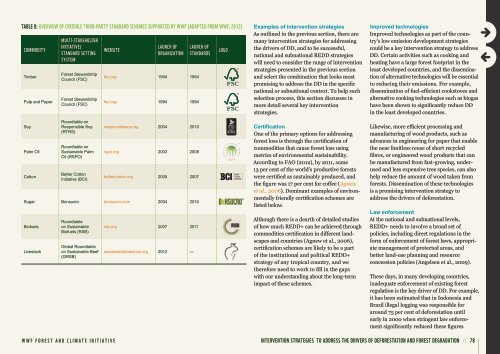WWF Guide to Building REDD+ Strategies
WWF Guide to Building REDD+ Strategies
WWF Guide to Building REDD+ Strategies
You also want an ePaper? Increase the reach of your titles
YUMPU automatically turns print PDFs into web optimized ePapers that Google loves.
taBle 8: oveRvieW oF CRediBle tHiRd-PaRty StandaRd SCHemeS SuPPoRted By <strong>WWF</strong> (adaPted FRom <strong>WWF</strong>, 2012)<br />
Commodity<br />
Timber<br />
Pulp and Paper<br />
Soy<br />
Palm Oil<br />
Cot<strong>to</strong>n<br />
multi-StakeHoldeR<br />
initiative/<br />
StandaRd SettinG<br />
SyStem<br />
Forest Stewardship<br />
Council (FSC)<br />
Forest Stewardship<br />
Council (FSC)<br />
Roundtable on<br />
Responsible Soy<br />
(RTRS)<br />
Roundtable on<br />
Sustainable Palm<br />
Oil (RSPO)<br />
Better Cot<strong>to</strong>n<br />
Initiative (BCI)<br />
WeBSite<br />
launCH oF<br />
oRGanization<br />
fsc.org 1994 1994<br />
fsc.org 1994 1994<br />
responsiblesoy.org 2004 2010<br />
rspo.org 2003 2008<br />
bettercot<strong>to</strong>n.org 2005 2007<br />
Sugar Bonsucro bonsucro.com 2004 2010<br />
Biofuels<br />
Lives<strong>to</strong>ck<br />
Roundtable<br />
on Sustainable<br />
Biofuels (RSB)<br />
Global Roundtable<br />
on Sustainable Beef<br />
(GRSB)<br />
<strong>WWF</strong> FOREST AND CLIMATE INITIATIVE<br />
rsb.org 2007 2011<br />
sustainablelives<strong>to</strong>ck.org 2012 —<br />
launCH oF<br />
StandaRdS<br />
loGo<br />
Examples of intervention strategies<br />
As outlined in the previous section, there are<br />
many intervention strategies for addressing<br />
the drivers of DD, and <strong>to</strong> be successful,<br />
national and subnational REDD strategies<br />
will need <strong>to</strong> consider the range of intervention<br />
strategies presented in the previous section<br />
and select the combination that looks most<br />
promising <strong>to</strong> address the DD in the specific<br />
national or subnational context. To help such<br />
selection process, this section discusses in<br />
more detail several key intervention<br />
strategies.<br />
Certification<br />
One of the primary options for addressing<br />
forest loss is through the certification of<br />
commodities that cause forest loss using<br />
metrics of environmental sustainability.<br />
According <strong>to</strong> FAO (2012), by 2011, some<br />
13 per cent of the world’s productive forests<br />
were certified as sustainably produced, and<br />
the figure was 17 per cent for coffee (Agnew<br />
et al., 2006). Dominant examples of environmentally<br />
friendly certification schemes are<br />
listed below.<br />
Although there is a dearth of detailed studies<br />
of how much <strong>REDD+</strong> can be achieved through<br />
commodities certification in different landscapes<br />
and countries (Agnew et al., 2006),<br />
certification schemes are likely <strong>to</strong> be a part<br />
of the institutional and political <strong>REDD+</strong><br />
strategy of any tropical country, and we<br />
therefore need <strong>to</strong> work <strong>to</strong> fill in the gaps<br />
with our understanding about the long-term<br />
impact of these schemes.<br />
Improved technologies<br />
Improved technologies as part of the country’s<br />
low emission development strategies<br />
could be a key intervention strategy <strong>to</strong> address<br />
DD. Certain activities such as cooking and<br />
heating have a large forest footprint in the<br />
least developed countries, and the dissemination<br />
of alternative technologies will be essential<br />
<strong>to</strong> reducing their emissions. For example,<br />
dissemination of fuel-efficient cooks<strong>to</strong>ves and<br />
alternative cooking technologies such as biogas<br />
have been shown <strong>to</strong> significantly reduce DD<br />
in the least developed countries.<br />
Likewise, more efficient processing and<br />
manufacturing of wood products, such as<br />
advances in engineering for paper that enable<br />
the near limitless reuse of short recycled<br />
fibres, or engineered wood products that can<br />
be manufactured from fast-growing, underused<br />
and less expensive tree species, can also<br />
help reduce the amount of wood taken from<br />
forests. Dissemination of these technologies<br />
is a promising intervention strategy <strong>to</strong><br />
address the drivers of deforestation.<br />
Law enforcement<br />
At the national and subnational levels,<br />
<strong>REDD+</strong> needs <strong>to</strong> involve a broad set of<br />
policies, including direct regulations in the<br />
form of enforcement of forest laws, appropriate<br />
management of protected areas, and<br />
better land-use planning and resource<br />
concession policies (Angelsen et al., 2009).<br />
These days, in many developing countries,<br />
inadequate enforcement of existing forest<br />
regulation is the key driver of DD. For example,<br />
it has been estimated that in Indonesia and<br />
Brazil illegal logging was responsible for<br />
around 75 per cent of deforestation until<br />
early in 2000 when stringent law enforcement<br />
significantly reduced these figures<br />
inteRvention StRateGieS <strong>to</strong> addReSS tHe dRiveRS oF deFoReStation and FoReSt deGRadation // 78

















